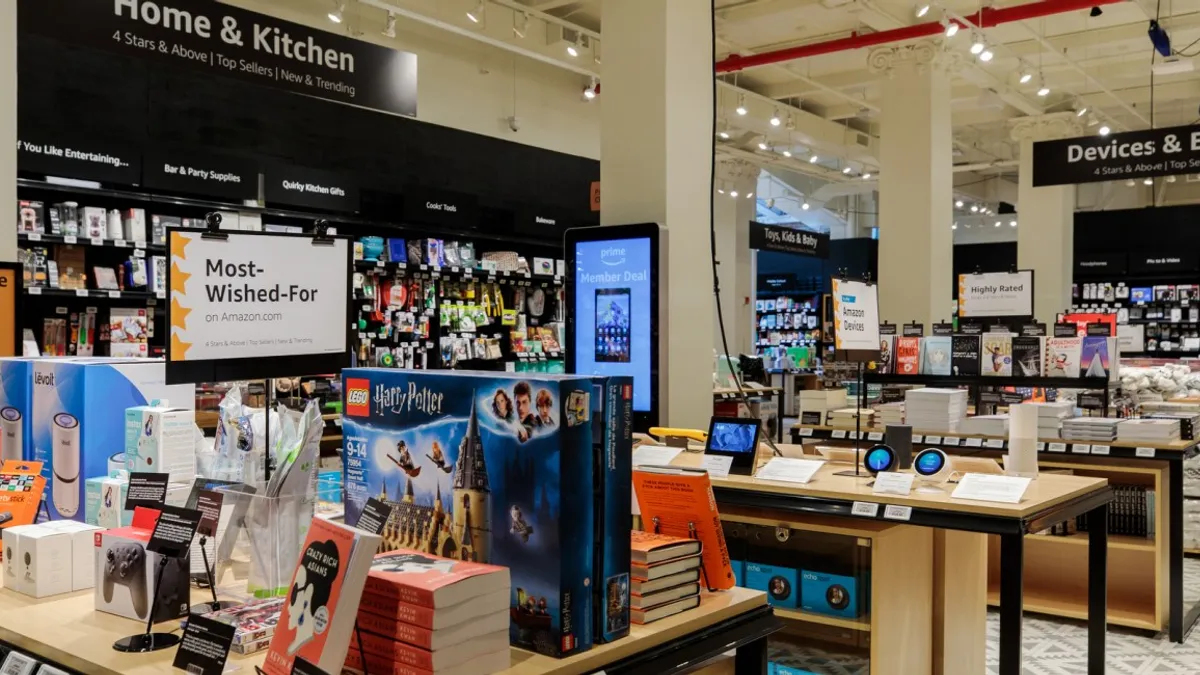Dive Brief:
-
Amazon runs some 629 physical retail locations, including its bookstores, Amazon Go convenience stores, Whole Foods grocery stores and traveling Treasure Trucks, according to a count by Amazon tracking site TJI Research.
-
To compile his unofficial map of Amazon's footprint, TJI Research founder Justin Smith included pop-ups that seem permanent, mostly at malls, but not more temporary installations, according to his blog post.
-
Included as separate stores are Allegro Coffee Roasters co-located at Whole Foods groceries in Denver, and Amazon pop-ups inside Whole Foods Markets, according to the blog post. Amazon didn't immediately return Retail Dive's request for confirmation of the numbers and information on future brick-and-mortar plans.
Dive Insight:
Amazon's footprint ballooned after the company's acquisition of Whole Foods — those stores alone number 480. But for an e-commerce juggernaut, the company runs a quite diverse physical store operation by TJI's measure, including six Amazon Go stores, two Amazon 4-Star locations, 18 bookstores, 10 Whole Foods 365 stores, seven coffee shops, 25 Treasure Trucks, 67 pop-ups and 14 "Smart Home Experience Pop-ups" (all of them concessions inside Kohl's stores).
Amazon's rivals are mostly going in the opposite direction, shuttering stores or pulling back on expansion plans. After shuttering 257 stand-alone mobile stores and bringing them into its flagship locations, for example, Best Buy now runs 1,252 stores. Targets operates 1,839 (which increasingly includes a mix of smaller format stores in urban neighborhoods and college campuses), and, of course, Walmart takes the cake, with 4,761 flagship stores in the U.S. alone, plus 597 Sam's Club warehouse stores (which represents a pull-back in its expansion amid a pivot to e-commerce).
An even larger question for Amazon than how many locations it runs — or plans to run — is how it runs them. The company in some ways is transforming brick-and-mortar retail with innovations like its cashier-less checkout. But in other ways it seems behind the curve — the company has garnered mostly lackluster reviews of its bookstores, for example. And its latest launch, Amazon 4-Star, unlike its other physical stores, seems an attempt to shoehorn an e-commerce approach into four walls, according to Instinet analysts led by Simeon Siegel, who said that it's missing the opportunities for discovery and connection inherent in brick and mortar.
"[W]e believe the store is a perfect brick-and-mortar manifestation of the Amazon online-shopping experience; i.e., there is a collection of bestsellers, but the shopping experience still feels somewhat overwhelming," according to the Instinet note emailed to Retail Dive. "Whereas Whole Foods, bookstores, and cashierless Go locations seem to offer something different than the Amazon homepage, Amazon 4-star appears to echo a (curated) collection of interesting top-sellers that are at your grasp if you know what you want, but still seem difficult to browse and discover if you don't."
Legacy retailers often excel at fostering discovery, partly because the literal, physical constraints of a brick-and-mortar store provide the outline and scale for "telling a story," Siegel said in an interview with Retail Dive. "There's a logic to it, somebody's helping you discover the merchandise," he said. "With the old school approach, they sent out catalogs, now they send out emails. There are experiences that allow for discovery. Merchandise is assorted and placed in a way that helps tell your story. The reality [at Amazon 4-Star] is — the best adjective is, unfortunately, 'overwhelmed.'"















